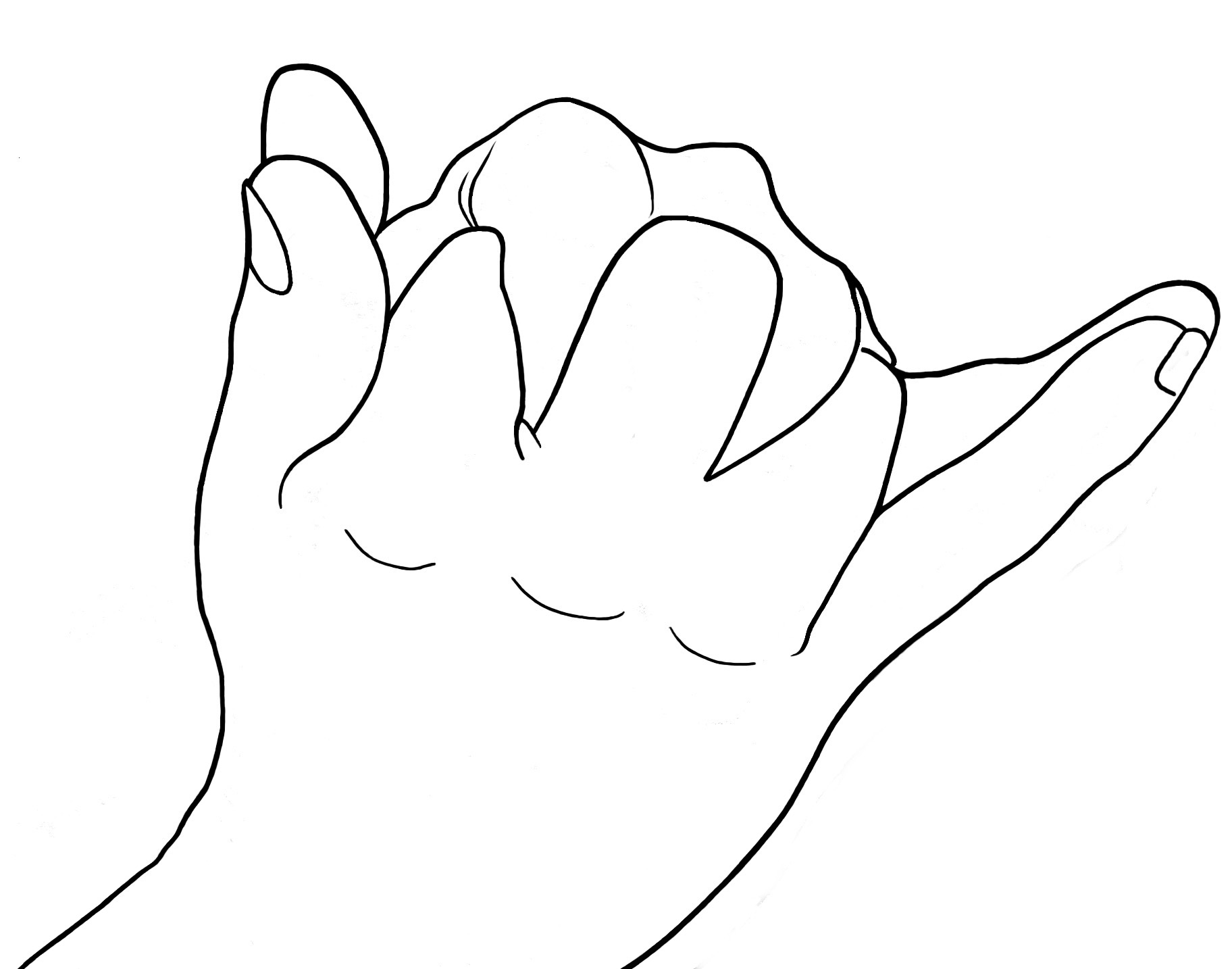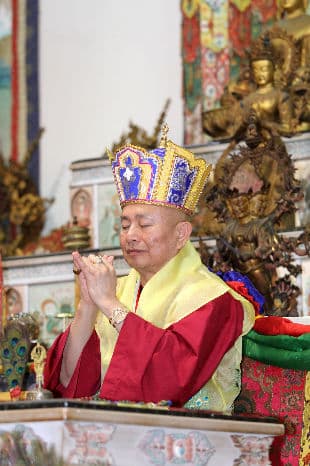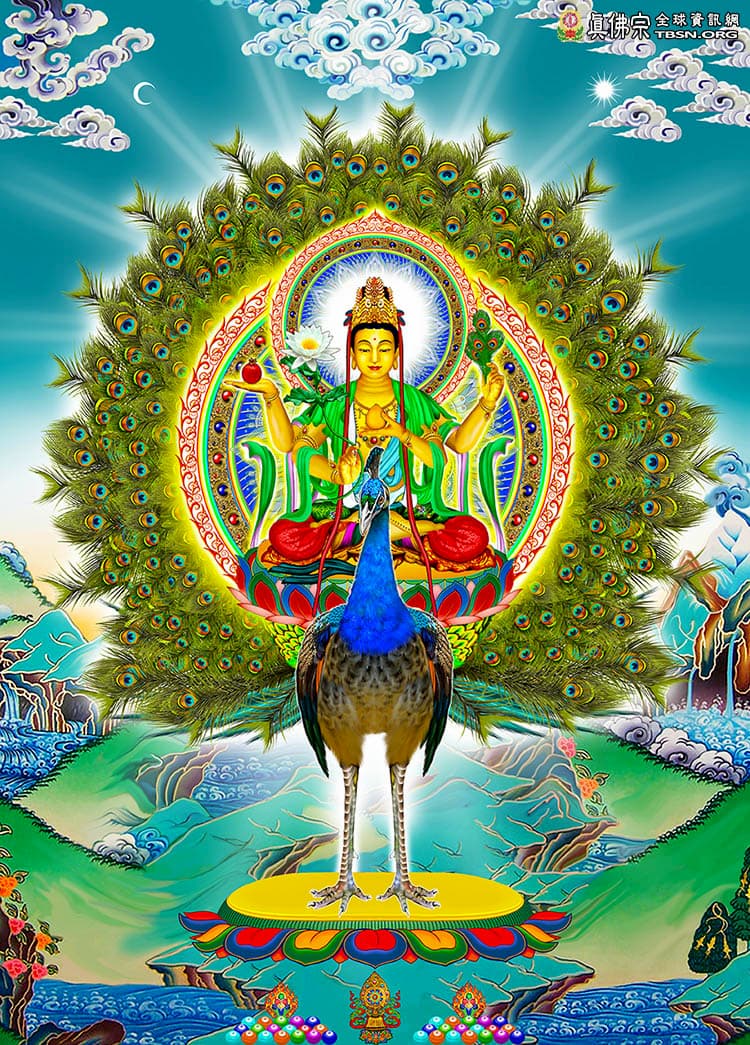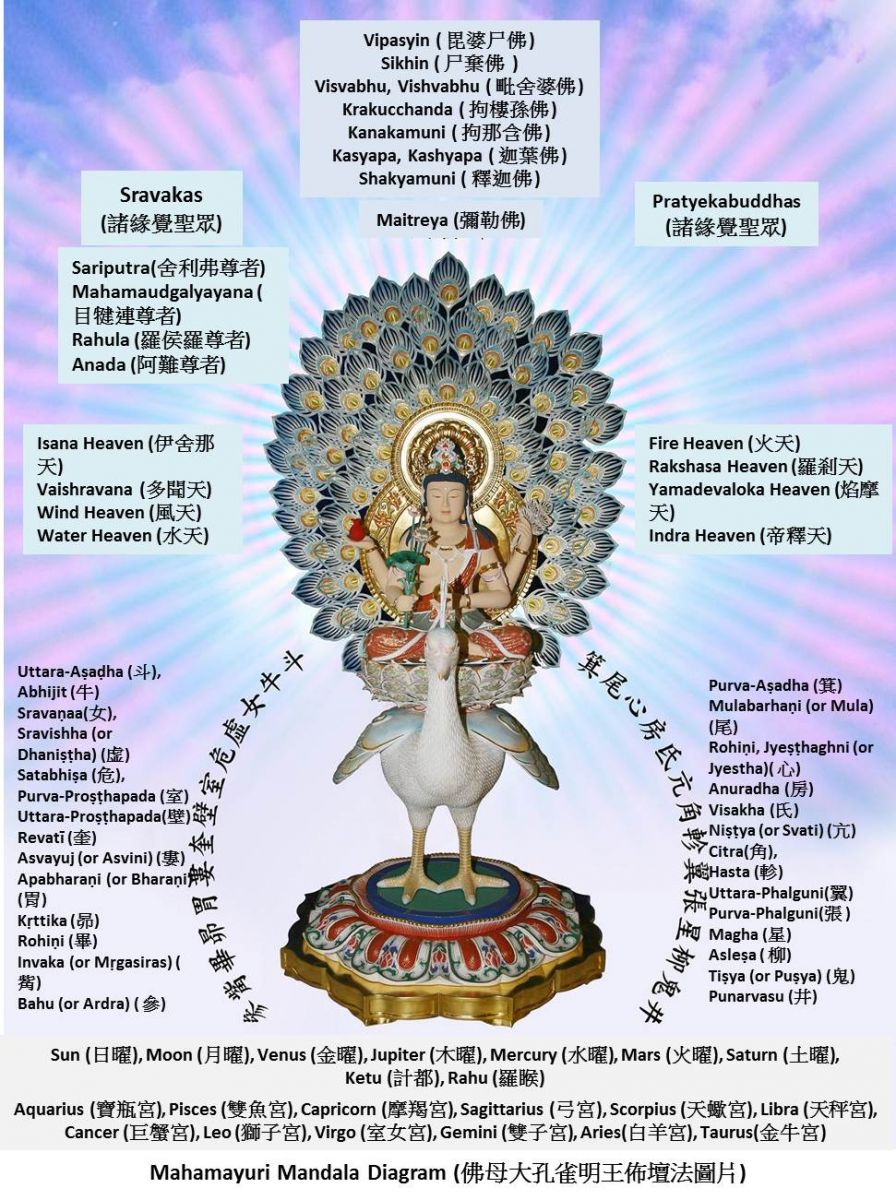On Sunday, Jan. 18, 2026, 3:00 PM, at Rainbow Temple, True Buddha School Dharma King Living Buddha Liansheng Sheng-yen Lu will preside over a Mahamayuri Homa Ceremony, discourse on the Surangama Sutra, and bestow empowerment for Mahamayuri Uncommon Practice. (Live Webcast Link: https://www.youtube.com/channel/UCLl20r-KQlapX_5fT-N3cOw )
【Mahamayuri Mudra :】 Inward Interlocking Mudra:


Interlock fingers inward in front of your chest, straighten both little fingers and thumbs, then press them close together. The thumbs represent the head of the peacock, the little fingers represent the tail feathers of the peacock, and the middle part represents the body of the peacock.
【Mahamayuri Seed Syllable :】

【Mahamayuri Mantra :】
Mantra 1:「Om。mo-yu-li。ge-la-di。so-ha。」
Mantra 2:「Om。di-ka。la-la。so-ha。」
【Mahamayuri Dharmalaksana Brief Introduction】


Mahamayuri wears a Mahavairocana crown. Her body can be all gold, all white, or both gold and white. She has four arms. The first right hand holds a white lotus, the second right hand holds red matulunga, the first left hand holds a yellow auspicious fruit, and the second left hand holds peacock feathers.
【Living Buddha Lian-sheng Sheng-yen Lu Dharma talk - Mahamayuri Background and Key Cultivation Formula】
Mahamayuri represents three buddhas:
Mahamayuri is the sambhogakaya of Shakyamuni Buddha because in one of his previous lives, Shakyamuni reincarnated as the Peacock King.
Mahamayuri is the nirmanakaya of Amitabha Buddha. According to the Amitabha Sutra, there are jivajivakas, peacocks, parrots, and kalavinkas in the Western Pure Land. The peacocks are the nirmanakaya of Amitabha Buddha.
Mahamayuri's appearance is one and the same as Mahavairocana's, very dignified. The Mahavairocana crown that Mahamayuri wears signifies her origin is Mahavairocana and that she is the nisyandakaya of Mahavairocana. Mahamayuri is therefore the primary integrated transformation of the three buddhas.
A peacock feather is placed in a Tantric empowerment vase to indicate that the empowerment vase itself is a transformation of Mahamayuri, that is, the empowerment vase is itself the emanation body of Mahamayuri.
Because Mahamayuri embodies the integrated dharma power of these three buddhas, she is even able to change predestined karma which otherwise would be impossible to avoid. Therefore, her power is infinite.
According to the Mahamayuri Sutra, during the time of the Buddha, a monk named Savatthi was bitten by a poisonous snake and suffered excruciating pain. When Anand related this incident to the Buddha, the Buddha taught a practice for eradicating demons, poison, and disease.
Mahamayuri belongs to the mother side of Vidyarajas, and of all the Vidyarajas, Mahamayuri is the one with a beautiful and compassionate aspect. She has four arms:
Her first right hand holds a white lotus symbolizing calamity eradication (removal of all calamities);Her first left hand holds a yellow auspicious fruit symbolizing increase in fortune (fortune increase in all aspects);
Her second right hand holds a red matulunga symbolizing love and respect (perfectly harmonization of affinities);
Her second left hand holds multi-colored peacock feathers symbolizing subjugation (subjugation of all demonic obstacles.).
Therefore, the four hands of Mahamayuri represent calamity eradication, fortune enrichment, love and respect, and subjugation. All the wishes of humans are in her hands. One can cultivate this deity's dharma for the purpose of calamity eradication, enrichment, magnetization, and subjugation.
Mahamayuri eats poison and can eat all the chemical toxins in one's body. When one detoxifies, one can be healthy, have longevity, and feel comfortable.
After eating a poisonous substance, peacocks will typically shine and radiate light. Their feathers become even more beautiful. Therefore, by reciting the Mahamayuri Mantra, those who take Ketamine or take other toxic substances by accident can be cleansed of toxins.
In addition, sickness can be cured by reciting the Mahamayuri Mantra. Her mantra has the power to cure sickness. To my recollection, Mahamayuri has many other practices, one of which is the Starlight Body Practice. If one desires to cultivate the Starlight Body Practice, one should recite the Mahamayuri Mantra because the 28 constellations and nine planets are her retinue. There is also Praying for Rain Practice. If during a drought, one prays to Mahamayuri for rain, it will rain. Look! Just as I was speaking of rain, it started to rain. Moreover, there is Stopping Rain Practice. If it rains excessively, Mahamayuri can stop the rain.
Furthermore, there is Earthquake Suppression Practice which is able to suppress an earthquake. To perform this practice, one first collects one kg of soil from the most northern point of the northern direction, the most southern point of the southern direction, the most eastern point of the eastern direction, and the most western point of the western direction respectively. After collecting these four kgs of soil, one cultivates the Earthquake Suppression Practice. After performing the practice, one returns the collected soil respectively back to where it was collected from. By performing this practice, Taiwan will no longer have any earthquakes. This is the so-called Earthquake Suppression Practice. This practice is rare. Only Mahamayuri has the power to suppress earthquakes.
Following are the key cultivation points of the Mahamayuri Sadhana:
Mahamayuri's Fourfold Refuge Mantra is different from our usual Fourfold Refuge Mantra.
Namo Guru Bei: I take refuge in the root guru.
Namo Mahamayuri: I take refuge in all buddhas.
Namo Mahamayuri Sutra: I take refuge in the Mahamayuri Sutra. This indicates one takes refuge in the Buddhadharma.
Namo Mahamayuri Assembly: Taking refuge in the Mahamayuri Assembly means taking refuge in all sanghas. Mahamayuri's assembly is comprised of the Seven Buddhas above, Maitreya in the center, Pratyekabuddhas and Sravakas on the left and right side respectively, Eight Heavenly Kings, 28 yaksas (constellations), Navagraha, and the 12 zodiac constellations. Altogether, these constitute the retinue of Mahamayuri.
The mandala (assembly diagram) of Mahamayuri: It can be laid out in writing as follows: Mahamayuri is in the center and can be represented with peacock feathers. Above Mahamayuri are the Seven Buddhas, then Maitreya, Pratyekabuddhas, Sravakas, and the Eight Heavenly Kings. Surrounding and below Mahamayuri are 28 yaksas, Navagraha, 12 zodiac constellations, and so on. This is Mahamayuri's retinue which includes the blessing retinue of her sambhogakaya, nirmanakaya, and nisyandakaya. Mahamayuri's mandala is arranged in this way.
To practice the Mahamayuri Sadhana, one must generate bodhicitta and make offerings to the deity. The offerings include external offerings, internal offerings, and dharma offerings. Dharma offerings are offerings of the Buddha-nature, that is, transforming one's Buddha-nature into Mahamayuri, one's attainment of spiritual union with Mahamayuri, and the unification of one's body, speech, and mind with Mahamayuri. This offering of Buddha-nature is extremely powerful and one cannot allow even the slightest mistake. This is what is called the Buddha-nature offering.
On a large scale, Mahamayuri can be practiced for peace at the national level. On a smaller scale, one may pray for a cure for swine flu or any new type of flu. According to the Mahamayuri Sutra, Mahamayuri Practice can cure all illnesses.
One who chants the Mahamayuri Mantra and achieves spiritual union with Mahamayuri will experience the emergence of their Buddha-nature. The Buddha-nature is truly the greatest.
One who completes 600,000 recitations of the Mahamayuri Mantra will certainly be reborn in Maha Twin Lotus Ponds. This is of utmost importance!
Living Buddha Lian-sheng Sheng-yen Lu, the great dharma king, compassionately transmitted the Mahamayuri Uncommon Practice, Starlight Body Practice, Praying for Rain Practice, Rain Stopping Practice, Earthquake Suppression Practice, Enrichment Practice, Love and Respect Practice, Body and Mind Purification Practice, Exorcism Practice, and Disease Eradication Practice.
For the True Buddha School Mahamayuri Sadhana and the mandala diagram, please follow the links below:
Mahamayuri Sadhana
Mahamayuri Mandala Diagram
!!Please be aware that before engaging in any True Buddha Vajrayana practices, one must first take refuge and receive the respective empowerment.!!
⓪Please check the True Buddha School website regularly for the latest news about Living Buddha Lian-sheng and ''be with Buddha'' always.
Welcome to download the user friendly True Buddha Video App from Appstore or Google Play. With the app you can see more of Grandmaster's marvelous videos and live webcasts. It is the speediest vehicle to ''keep you synchronized and be with the Buddha!''
Official True Buddha School Net (TBSN):
Home page: http://tbsn.org/
Indonesia Home Page: http://tbsn.org/indonesia/
Official Facebook Pages:
Chinese: www.facebook.com/syltbsn
English: https://www.facebook.com/syltbsnenglish
Indonesia: https://www.facebook.com/syltbsnindonesia
⓪Welcome fans (Vajra Dharma Protectors) of the Official English True Buddha Facebook site to invite their friends to join the Fan Club. Better yet, click ''Like'' and ''Share.'' Let us together spread the name of Dharma King Living Buddha Lian-sheng to every corner of the world!!







